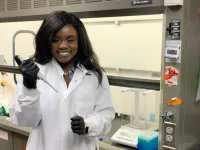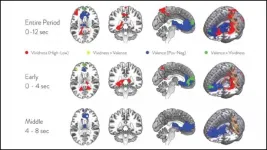Study reveals new options to help firms improve the food recall process
2021-05-17
(Press-News.org) For much of the nation's food supply, removing unsafe products off of store shelves can take up to 10 months, according to news reports -- even when people are getting sick.
The growing complexity and scope of modern supply chains result in painfully slow product recalls, even when consumer well-being is at stake. For example, in 2009, salmonella-tainted peanuts killed nine people and sickened more than 700 in 46 states, and the resulting nationwide recall cost peanut farmers, their wholesale customers and retailers more than $1 billion in lost production and sales. Tyson Foods' 2019 recall of nearly 12 million pounds of frozen chicken strips also cost the company millions.
The risk to health increases for each day that bad food remains in circulation, and little is known about food companies' underlying recall process to identify and remove tainted products from the supply chain. However, new research from the University of Notre Dame helps to close the gap between what is and isn't known about food recalls.
There are two key drivers of recall uncertainty -- upstream and downstream complexity, according to "Food for Thought: Recalls and Outcomes," forthcoming in the Journal of Business Logistics from lead author Kaitlin Wowak, associate professor of information technology, analytics and operations in Notre Dame's Mendoza College of Business.
"This research is the first to propose that managers embed recall options into their decision-making when trying to manage recall uncertainty," Wowak said. "Our study suggests that product recalls may not cleanly fall into recall categories as previously thought, but instead take the form of recall layering -- that is, nested recalls or a recall within a larger recall. Understanding that recall layering may be present can help companies segment a recall to more effectively manage it."
Recall options give decision-makers the opportunity but not the obligation to take certain actions in the future and can help managers make better-informed decisions as the recall process unfolds. Wowak says three recall options emerged from the study, all of which can provide major potential value under conditions of recall uncertainty.
"Scale options enable managers to expand recalls over time," she noted. "Deferral options allow managers to postpone executing a recall until a later point in time when they have a better understanding of the recall situation, and abandonment recall options occur when a recall was incorrectly initiated and thus is terminated when more information is revealed."
The study suggests that recall layering can inform a firm's strategy for how to effectively manage recalls as they evolve. For example, when a firm encounters the need for a recall, it can invoke different recall options depending on the nested recalls that surface within the larger recall.
"The specific nested recalls that emerge may change from recall to recall and could evolve as the larger recall unfolds, depending on the degree of uncertainty," Wowak explained. "Assume a firm initiates a recall that has a high degree of upstream complexity. A nested recall within that larger recall could be effectively managed with a deferral recall option. Once the firm has a better understanding of the situation, the next nested recall that emerges may be effectively managed with a scale recall option."
The study provides insights about which recall options may be used in various situations to help decision-makers manage the recall when facing uncertainty and makes designing, revising and improving the recall process more actionable for managers and scholars.
INFORMATION:
The team, including co-authors Christopher Craighead from the University of Tennessee and David Ketchen Jr. and Brian Connelly from Auburn University, conducted 55 interviews involving 21 different entities along the entire supply chain (farms, manufacturers, distribution centers/retailers and logistics providers) as well as nonprofit organizations, federal governmental agencies and subject matter experts over multiple years.
ELSE PRESS RELEASES FROM THIS DATE:
2021-05-17
Viruses attack the body by sending their genetic code -- DNA and RNA -- into cells and multiplying. A promising class of therapeutics that uses synthetic nucleic acids to target and shut down specific, harmful genes and prevent viruses from spreading is gaining steam.
However, only a handful of siRNA, or other RNA interference-based therapeutics have been approved. One of the main problems is getting the siRNA into the body and guiding it to the target.
Chemical engineering researchers in the Cockrell School of Engineering aim to solve that problem, while improving the targeting effectiveness of siRNA. In a new paper in the Journal of Controlled Release, the researchers created several different types of nanoparticles and analyzed them for the ability to deliver and protect siRNA from ...
2021-05-17
May 17, 2021 - Amid the rising toll of opioid overdoses and deaths in the U.S., several states are considering laws enabling civil commitment for involuntary treatment of patients with substance use disorders (SUDs). Most addiction medicine physicians support civil commitment for SUD treatment - but others strongly oppose this approach, reports a survey study in Journal of Addiction Medicine, the official journal of the American Society of Addiction Medicine (ASAM). The journal is published in the Lippincott portfolio by Wolters Kluwer.
"Civil commitment has emerged as a sometimes compelling yet controversial policy option," according to the new study, led by Abhishek Jain, MD. At the time of ...
2021-05-17
Some 16 million Americans are believed to have alcohol use disorder, and an estimated 93,000 people in the U.S. die from alcohol-related causes each year. Both of those numbers are expected to grow as a result of heavier drinking during the COVID-19 pandemic.
Yet, in a new study involving data from more than 200,000 people with and without alcohol problems, researchers at Washington University School of Medicine in St. Louis found that although the vast majority of those with alcohol use disorder see their doctors regularly for a range of issues, fewer than one in 10 ever get treatment for drinking.
The findings are published in the June issue of the journal Alcoholism: Clinical & Experimental Research.
Analyzing data gathered from 2015 through 2019 via the National ...
2021-05-17
In a world that's changing fast, the Long Term Ecological Research (LTER) Network can seem almost an anachronism. Yet the patience and persistence that have generated 40 years of careful, reliable science about the Earth's changing ecosystems may prove to be just what's needed in this rapidly shifting world. We can't wait for a crystal ball -- and we don't have to. By harnessing decades of rich data, scientists are beginning to forecast future conditions and plan ways to manage, mitigate, or adapt to likely changes in ecosystems that will impact human economies, health and wellbeing.
The National Science Foundation established the LTER Network more than 40 years ago to provide an alternative to funding models that favored constant innovation over continuity. The model has proven to be extraordinarily ...
2021-05-17
An international study has found that four out of five women in prison in Scotland have a history of head injury, mostly sustained through domestic violence. Published recently in The Lancet, researchers, including SFU psychology graduate student Hira Aslam, say the study has important implications for the female prison population more broadly and could help to inform mental health and criminal justice policy development.
"The findings are incredibly sobering," says Aslam. "While we anticipated that the incidence of head injuries among women who are involved in the criminal justice system would be high, these estimates exceeded our expectations."
Researchers also found that violent criminal behaviour was three times more likely among women who had a history of significant head injury, ...
2021-05-17
ATS 2021, New York, NY - Air quality standards recommended by the American Thoracic Society (ATS) have the potential to prevent more illness and death than standards adopted by the U.S. Environmental Protection Agency (EPA), according to research presented at the ATS 2021 International Conference.
Laura Gladson, MS, a research scholar with the Air Quality Program at the Marron Institute of Urban Management, New York University (NYU) and colleagues from NYU and the ATS assessed differences between the potential public health protections provided by EPA air quality standards and the more stringent standards proposed by the ATS. Comparing real-world ...
2021-05-17
Two components of imagination -- constructing and evaluating imagined scenarios -- rely on separate subnetworks in the default mode network, according to research recently published in JNeurosci.
Even when you aren't doing anything, your brain is hard at work. The default mode network (DMN) activates during the brain's resting state and has been linked to daydreaming, planning, and imagining the future. In previous studies, scientists noticed the DMN could be divided into two subnetworks, ventral and dorsal, but their different roles were debated.
Lee et al. used fMRI to measure participants' brain activity while they imagined scenarios listed on prompts, like "Imagine you win the lottery." The scenarios ...
2021-05-17
KINGSTON, R.I. - May 17, 2021 - An article recently published in the prestigious journal Nature Communications, written by University of Rhode Island END ...
2021-05-17
Clinicians and surgeons are increasingly using medical devices based on artificial intelligence. These AI devices, which rely on data-driven algorithms to inform health care decisions, presently aid in diagnosing cancers, heart conditions and diseases of the eye, with many more applications on the way.
Given this surge in AI, two Stanford University faculty members are calling for efforts to ensure that this technology does not exacerbate existing heath care disparities.
In a new perspective paper, Stanford faculty discuss sex, gender and race bias in medicine and how these biases could be perpetuated by AI devices. The authors suggest several short- and long-term approaches to prevent AI-related ...
2021-05-17
BOSTON - Peripheral artery disease (PAD), or blockages in the arteries outside of the heart, affects more than 200 million people worldwide and 12.5 million people in the United States. Patients with this circulatory disorder may develop severe leg pain or unhealing wounds that require a minimally invasive revascularization procedure to open the blood vessels to improve blood flow.
For nearly a decade, proceduralists and surgeons have depended on devices coated with a drug called paclitaxel -- which reduces the need for another procedure by up to 50 percent -- during procedures to open the arteries of the leg. However, in the wake of a 2018 study that found a potential link between ...
LAST 30 PRESS RELEASES:
[Press-News.org] Study reveals new options to help firms improve the food recall process



